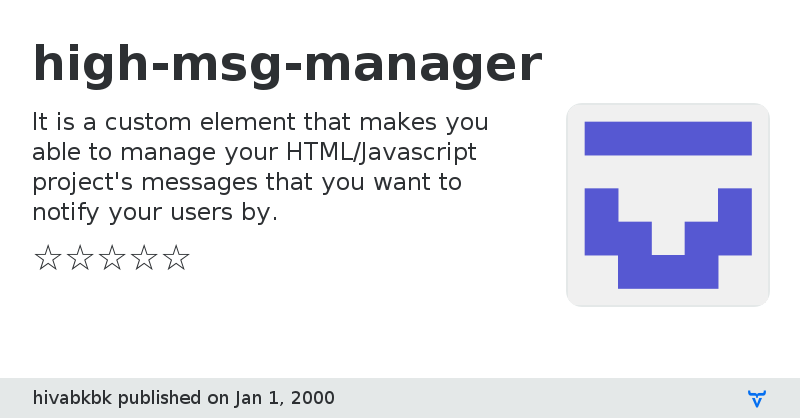high-msg-manager - Vaadin Add-on Directory
It is a custom element that makes you able to manage your HTML/Javascript project's messages that you want to notify your users by.
# high-msg-manager (HMM)
It is a custom element that makes you able to manage your HTML/Javascript project's messages that you want to notify your users by.
[Live Demo](https://dictiwa.com/high-msg-manager/)
# Scenario
There is a message manager(`high-msg-manager`) which control messages(`high-msg`) it contains. we can add messages by putting `high-msg` tags in manager or using `add` method of the manager. messages could be stored by having an id attribute. then we show the message by using manager's `show` method or just simply removing message's hidden attribute/property.
- so if you want to store your messages in the manager give them an id attribute so later you could target them.
- or if you want to regenerate a message anytime you need one, just add it at the moment. (remember you still can store messages using manager's add method by giving them an id property.)
- if you have a message with dynamic content you can use [templating](#templating).
# Installation
You can use `high-msg-manager` via script tag or npm.
## Script Tag
add below tag to your html document
```html
```
## npm
```npm
npm install high-msg-manager --save
```
once you installed the package, you can add this tag to your html document
```html
```
## dependencies
To make Edge and most of another old modern browsers support HMM, add pollyfill to your project like this:
```html
```
also Edge does not read the internal styles so if you want Edge support add this tag to your document too:
```html
```
# Usage
First, you need to create your HMM tag.
```html
You did right!
```
## high-msg attributes
### static
messages with a static attribute, won't disappear until the user clicks on them, so defining a duration for them would be useless.
### hidden
simply hide the message. if you define a stored message you must give it a hidden attribute unless you mean that.
### duration
Message's appearing duration depends on how long or important it is so you can give messages a specific duration.
### id
when you give a message an id attribute it means you want to target that message later, so they won't be deleted on disappearing, they just got hidden(messages without an id will be deleted on disappearing as you guessed). so later you can just show them.
### type
default message's types are warn, success and error which you can expand them by adding some types of styles in your CSS, like this:
```css
// defining a new type
high-msg[type=whatever]{
some styles
}
```
# templating
consider a situation that you need a stored message with dynamic content meaning parts of message's content is relative. for example we want to show time to user every minute. using templating in this situation is reasonable. we define some variable and when we want to show the message we provide the values. variable define like this `${...}`
```html
The time is ${time}
```
# javascript
we have to method to manipulate messages by javascript, `add` and `show`.
## add method
to add a message dynamically, select the high-msg-manager and use `add` method. it accept an key value javascript's object.
```javascript
document.querySelector("high-msg-manager").add({
'id': string, // it is optional, using it make the message stored.
'type': string, // type of message, could be warn, success, error or a custom type
'content': string, // using ${...} inside of it define a template for the message
'values': object, // if you use templating, providing this as a javascript object with key of variable name and custom value makes the template work.
'static': boolean, // message should be static or not
'duration': number,
'hidden': boolean, // do you want to show it right after? then make hidden false
'priority': string, // high or nothing, appear at the top of appearing messages list.
});
```
### example
```javascript
document.querySelector("high-msg-manager").add({
'id': 'showing_time',
'type': 'warn',
'content': 'the time is ${time}',
'values': {time: '12:30:12'}
'duration': 3
'priority': true
});
```
## show method
to show a message using show method we must have that message with a known id.
```javascript
document.querySelector("high-msg-manager").show({
'id': string, // which mesage you want to show?
'content': string, // if you want to use original content of message don't provide this
'values': object, // template's values
'static': boolean, // message should be static or not
'duration': number
});
```
### example
```javascript
document.querySelector("high-msg-manager").show({
'id': 'showing_time',
'values': {time: '12:32:55'}
});
```
## Contributing
1. Fork it!
2. Create your feature branch: `git checkout -b new-feature`
3. Commit your changes: `git commit -am 'Add some feature'`
4. Push to the branch: `git push origin new-feature`
5. Submit a pull request :D
## License
MIT LICENSE
View on GitHubView on NPM
high-msg-manager version 0.0.1
### Dependencies
high-msg-manager version 0.0.2
### Dependencies
high-msg-manager version 0.0.3
### Dependencies
high-msg-manager version 0.0.4
### Dependencies
high-msg-manager version 0.0.5
### Dependencies
high-msg-manager version 0.0.6
### Dependencies